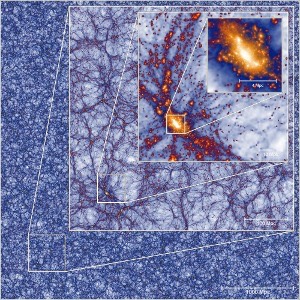The Aim of This Conference
Measuring the distribution of matter in the universe as a function of time and space is a powerful probe of cosmology.
It offers a unique test of how gravity works on scales much greater than the conventional tests of General Relativity, and is considered as the most sensitive probe of the origin of the cosmic acceleration. Statistical properties of matter distribution can also constrain the nature of initial fluctuations, hence the physics of inflation, and the mass of neutrinos.
Observations of the large-scale structure of the universe are improving rapidly, pushing the survey volume and redshifts to unprecedented territory with various tracers such as passive and emission-line galaxies, quasars, dusty galaxies, Lyman-alpha forests, 21-cm line emissions, and gravitational lenses.
The rapid growth in the survey data demands much improved theoretical understanding of the large-scale structure. Unlike the cosmic microwave background fluctuations, the distribution of matter is non-linear, and thus we need a combination of non-linear theories and numerical simulations to properly interpret the existing and upcoming data.
This conference is organised in a unique time, in which the new generation of large-scale structure surveys have started/are starting to acquire data (e.g., eBOSS, VIPERS, DES, HSC/PFS, HETDEX, eROSITA and eventually Euclid and SKA), and we are witnessing a rapid progress in the theoretical understanding. We propose to bring together leading experts in both theory and observations of the large-scale structure of the universe to discuss the recent progress and future directions.
- PDF files of the talk slides are available here (August 9, 2015)
Dates and Venue
- Dates: July 20-24, 2015
- Venue: Headquarters of the European Southern Observatory (ESO), Auditorium “Eridanus”
- Conference Fees: 130 EUR for regular participants; 80 EUR for students
- For registration, click here
External Scientific Organization Committee (SOC)
- Raul Angulo (Centro de Estudios de Física del Cosmos de Aragón)
- Sarah Bridle (University of Manchester)
- Gigi Guzzo (Osservatorio Astronomico di Brera / Universita di Milano-Bicocca)
- Rachel Mandelbaum (Carnegie Mellon University)
- John Peacock (University of Edinburgh)
- Roman Scoccimarro (New York University)
- Romain Teyssier (University of Zürich)
- Licia Verde (University of Barcelona / University of Oslo)
Local Organization Committee (LOC)
- Rob Ivison (European Southern Observatory)
- Guinevere Kauffmann (Max-Planck-Institut für Astrophysik)
- Eiichiro Komatsu (Max-Planck-Institut für Astrophysik)
- Ariel Sánchez (Max-Planck-Institut für Extraterrestrische Physik)
- Fabian Schmidt (Max-Planck-Institut für Astrophysik)
- Eelco van Kampen (European Southern Observatory)
- Jochen Weller (Ludwig-Maximilians-Universität München)




